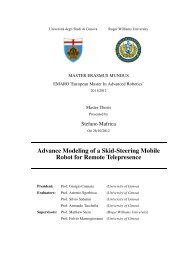East Bay Coalition for the Homeless - Roger Williams University
East Bay Coalition for the Homeless - Roger Williams University
East Bay Coalition for the Homeless - Roger Williams University
Create successful ePaper yourself
Turn your PDF publications into a flip-book with our unique Google optimized e-Paper software.
5. Networked nonprofits know how to inspire people. Networked nonprofits motivate <strong>the</strong>ir networks of support<br />
to help shape <strong>the</strong> organization’s programs, to share <strong>the</strong>ir stories in order to raise awareness of social issues, to change<br />
attitudes and behavior, and to organize communities to provide services or advocate <strong>for</strong> legislation.<br />
6. Networked nonprofits work differently. They enjoy a social culture that encourages everyone in and outside <strong>the</strong><br />
organization to participate and spread <strong>the</strong> organization’s mission. They have challenged deep-set organizational assumptions<br />
about leadership, roles, and structures. They have broken down departmental silos. They are com<strong>for</strong>table<br />
sharing control or co-creating with <strong>the</strong>ir networks—whe<strong>the</strong>r that means allowing people to reteil <strong>the</strong> organization’s<br />
story in <strong>the</strong>ir own words or scaling programs.<br />
7. Networked nonprofits are masters at using social media. They are adept at using tools that encourage conversations<br />
and building relationships between people, and between people and organizations. They are able to scale <strong>the</strong>ir<br />
ef<strong>for</strong>ts quickly, easily, and inexpensively. Networked nonprofits are adept at blending tried and true methods with<br />
new digital tools. They also understand how to dance between <strong>the</strong> spontaneous nature of social media and strategic<br />
communications.<br />
The Crawl, Walk, Run, Fly Model<br />
As Martin Lu<strong>the</strong>r King said:<br />
“If you can’t fly <strong>the</strong>n run, if you can’t run <strong>the</strong>n walk, if you can’t walk <strong>the</strong>n crawl, but whatever you do you have to keep<br />
moving <strong>for</strong>ward.”<br />
The Crawl, Walk, Run, Fly hierarchy is designed to help organizations understand that becoming a networked nonprofit<br />
is typically a complex and lengthy process. Its purpose is to encourage and motivate organizations to succeed by<br />
helping <strong>the</strong>m understand <strong>the</strong> nature of <strong>the</strong> process <strong>the</strong>y are going through. This model is simply a method <strong>for</strong> organizations<br />
to figure out how where to focus time and learning to get to <strong>the</strong> next stage. It can also be used as a framework<br />
<strong>for</strong> designing and evalation peer learning networks.<br />
Not every nonprofit will go through <strong>the</strong> levels at <strong>the</strong> same pace, as different organizations have different cultures,<br />
capacities, communication objectives, program designs, and target audiences. And <strong>the</strong> reality will be messy; an organization<br />
might not precisely fit <strong>the</strong> profile in any specific category, But every organization can take pride in <strong>the</strong>ir<br />
success at whatever <strong>the</strong>y hae acheived.<br />
Crawl<br />
Organizations that are in <strong>the</strong> “Crawl” stage of becoming networked nonprofits are not using social media or emerging<br />
technology at all, or if <strong>the</strong>y are using it, <strong>the</strong>y’re not using it consistently and are not using any measurement processes.<br />
These organizations lack a robust communications strategy or program plan that can be scaled using a networked<br />
approach. “Crawlers” are not just smaller nonprofits, but may include larger institutions that have all <strong>the</strong> basics in<br />
place, but lack a social culture or are resisting trans<strong>for</strong>ming from a command-and0control style to a more networked<br />
mindset.<br />
117
















